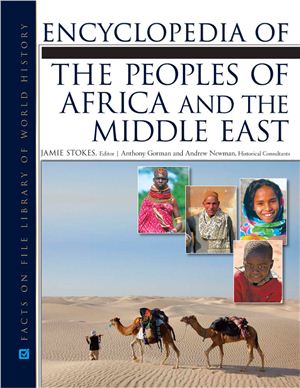Pages: 841.
Publisher: Facts On File (2009).
Quality: good: pdf.
About 900 entries cover ancient and mode groups, from Ababda to Zulu. Some entries are only a sentence or two long when the people constitute a subgroup; the Ababda,for example, are a subgroup of the Beja people of Sudan. Larger entries, such as Zulu (2 pages) and Arabs (19 pages), include sections on the group’s origins, language, history, and culture. Large entries also have maps, pictures, time lines, and a list of further reading. Fact boxes offer basic information such as location, ancestry, and language; and sidebars contain biographical profiles. Some of the entries, such as South Africans and Sudanese, are based on nationality and provide information on geography, inception as a nation, and cultural identity. Each volume has a table of contents, list of entries, and list of illustrations and maps for the set, as well as a map of Africa and the Middle East. The second volume has appendixes that include a list of the people featured in biographical sidebars, descriptions of the geography of Africa and the Middle East, an essay on human evolution, a chronology of Africa and the Middle East from prehistoric times to 2008, and a Glossary of Cultural Terms. The appendixes are followed by a bibliography and an index. Up-to-date and well researched, this set is an excellent resource for undergraduate libraries as well as public libraries. Also available as an e-book.
ISBN 978-0-8160-7158-6 (hardcover : alk. paper).
ISBN 978-1-4381-2676-0 (e-book).
Publisher: Facts On File (2009).
Quality: good: pdf.
About 900 entries cover ancient and mode groups, from Ababda to Zulu. Some entries are only a sentence or two long when the people constitute a subgroup; the Ababda,for example, are a subgroup of the Beja people of Sudan. Larger entries, such as Zulu (2 pages) and Arabs (19 pages), include sections on the group’s origins, language, history, and culture. Large entries also have maps, pictures, time lines, and a list of further reading. Fact boxes offer basic information such as location, ancestry, and language; and sidebars contain biographical profiles. Some of the entries, such as South Africans and Sudanese, are based on nationality and provide information on geography, inception as a nation, and cultural identity. Each volume has a table of contents, list of entries, and list of illustrations and maps for the set, as well as a map of Africa and the Middle East. The second volume has appendixes that include a list of the people featured in biographical sidebars, descriptions of the geography of Africa and the Middle East, an essay on human evolution, a chronology of Africa and the Middle East from prehistoric times to 2008, and a Glossary of Cultural Terms. The appendixes are followed by a bibliography and an index. Up-to-date and well researched, this set is an excellent resource for undergraduate libraries as well as public libraries. Also available as an e-book.
ISBN 978-0-8160-7158-6 (hardcover : alk. paper).
ISBN 978-1-4381-2676-0 (e-book).

